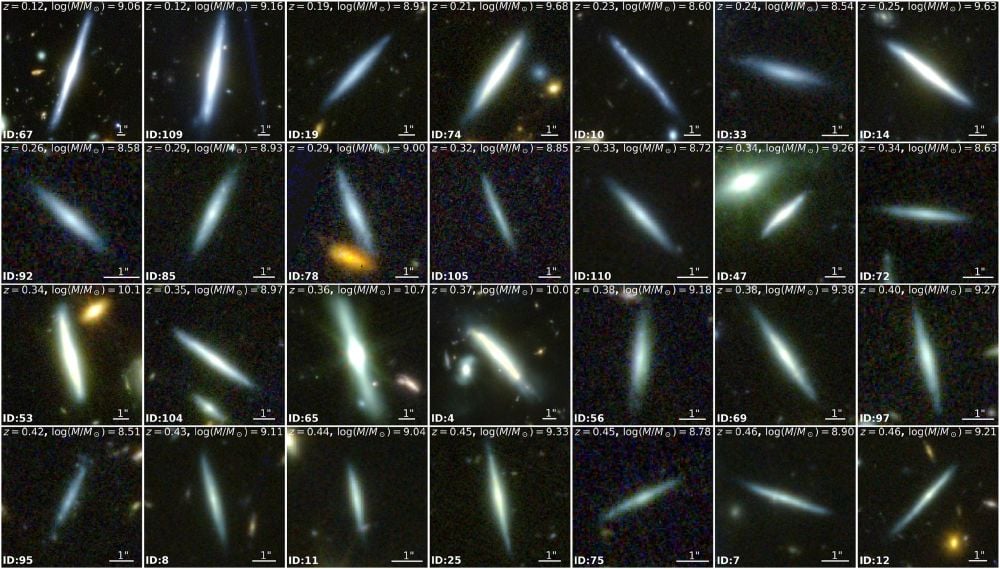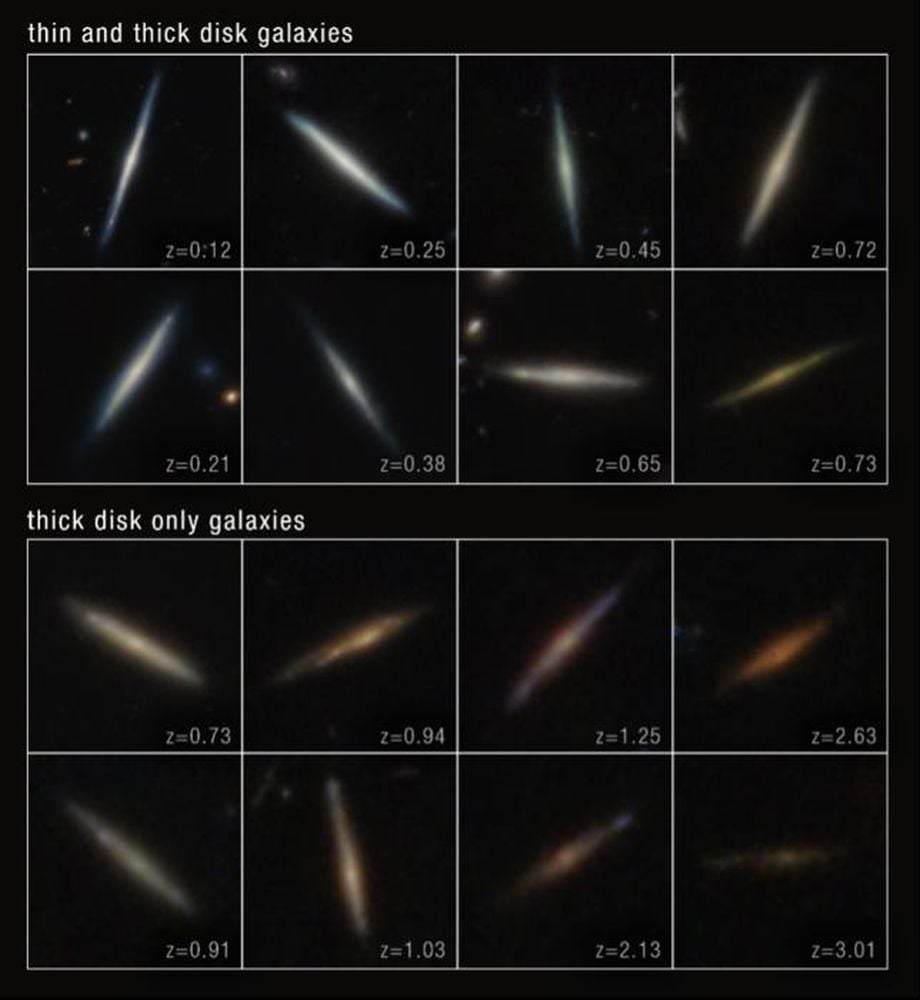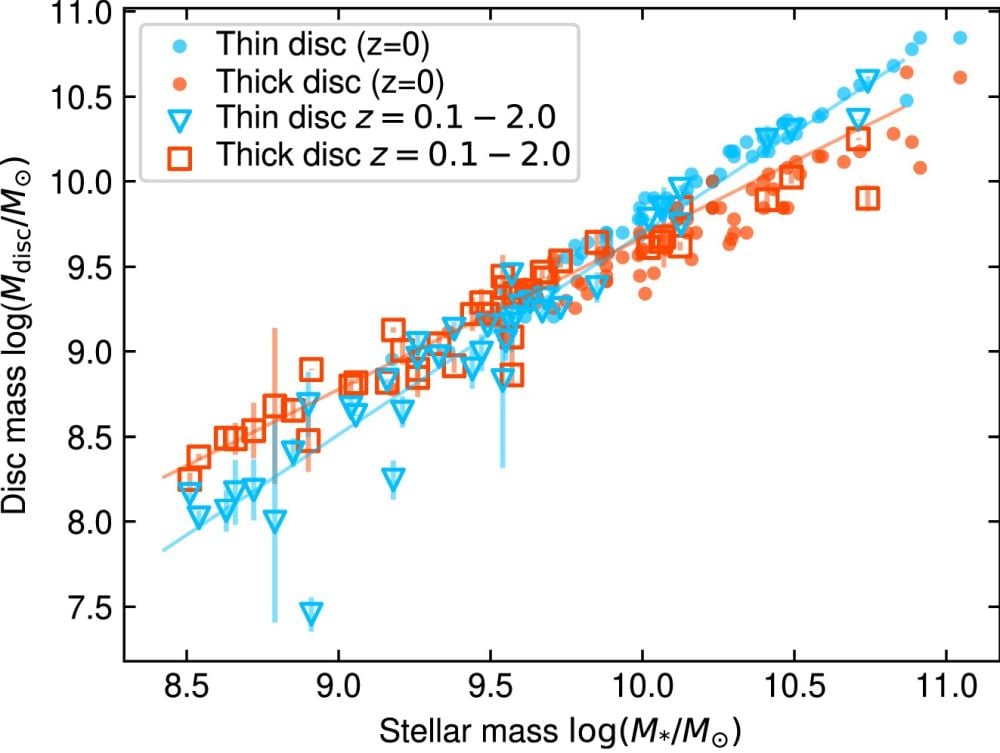Research shows that modern disk galaxies have two overall components: a thin disk containing higher-metallicity young stars, and a thick disk containing lower-metallicity older stars. The thin disk sits inside the thick disk. Astronomers are trying to understand how these parts form and how disk galaxies evolve. To make progress, astronomers need to observe edge-on rather than face-on galaxies. They also need to observe them in the past, something that the JWST is built to do.
Astronomers think that the thick disks went through a rapid formation phase earlier in a galaxy’s history, while the thin disks formed later during a more prolonged phase. This gave the thin disks more opportunity to accumulate metal from the interstellar medium (ISM). Researchers have come up with three main mechanisms to explain the difference between the disks.
The first is the ‘born hot’ scenario. This scenario says that the thick disk forms first due to intense star formation. During that phase, the disk is intensely turbulent and hot. Initially, that inhibits the thin disk from forming. Later, when things have calmed down, the thin disk forms with its younger and higher metallicity stars.
The second is the ‘progressive thickening’ scenario. It says that stars initially form near the mid-plane of the disk. Then the disk heats up and thickens due to density fluctuations or perturbations from giant molecular clouds, galaxy interactions or mergers, spiral arms, or possibly giant clumps.
The third scenario is ex situ scenario. It says that mergers or accretions are necessary to form the thick disk. However, current observations don’t seem to support this.
“All mechanisms can explain observed qualitative signatures of the Milky Way’s two discs, and they are not necessarily mutually exclusive,” a group of researchers explain in their new paper.
The paper is titled “The emergence of galactic thin and thick discs across cosmic history ,” and it’s published in The Monthly Notices of the Royal Astronomical Society. The lead author is Takafumi Tsukui. Tsukui is a post-doctoral fellow at Tohoku University in Sendai, Japan.
The researchers examined 111 JWST images of edge-on disk galaxies. The galaxies’ alignments allowed the JWST to observe their vertical disk structures. “Edge-on galaxies uniquely allow for direct study of their disc vertical structure and the decomposition of the thin and thick disc components,” the authors write in their research. “In this paper, we construct an edge-on galaxy sample with a careful visual inspection using ever-increasing JWST public images and investigate the thin and thick disc structures for the first time at cosmological redshifts up to redshift , roughly 10 Gyr ago,” they write.
 This figure from the research shows one-quarter of the researchers sample of edge-on galaxies. They’re organized by increasing redshift. Image Credit: Tsukui et al. 2025 MNRAS
This figure from the research shows one-quarter of the researchers sample of edge-on galaxies. They’re organized by increasing redshift. Image Credit: Tsukui et al. 2025 MNRAS
“Thanks to the JWST’s sharp vision, we were able to identify thin and thick disks in galaxies beyond our local universe, some going as far back as 10 billion years ago,” lead author Tsukui said in a press release.
Not all of the 111 galaxies are made up of two disks. “Of the 111 galaxies in our sample, we find that 28 galaxies are well fit by a single disc component, 39 are best fit by a single disc + bulge, 19 are best fit by two disc components, and 25 are best fit with two disc components + bulge,” the researchers explain.
“We identify well-defined correlations between some measured disc parameters across our sample, despite the wide baseline across cosmic time,” the authors write. The observations showed that disk galaxies followed a clear trend. In the earlier universe, more galaxies had a single thick disk. But in later epochs, more galaxies had a two-layered structure with an additional thin disk component. That evidence supports the idea that galaxy formation began with a thick disk, and that the thin disk formed later. Observations also showed that more massive galaxies formed their thin disks earlier.
 The figures illustrate the revealed sequential disk formation in this study: thick disk only galaxies dominate the early epochs (bottom panel), while galaxies exhibiting both thin and thick disks appear more commonly in later epochs of the universe (top panel). Image Credit: NASA, ESA, CSA, T. Tsukui
The figures illustrate the revealed sequential disk formation in this study: thick disk only galaxies dominate the early epochs (bottom panel), while galaxies exhibiting both thin and thick disks appear more commonly in later epochs of the universe (top panel). Image Credit: NASA, ESA, CSA, T. Tsukui
By measuring the ages of stars in the Milky Way and comparing them to the 111 galaxies, the researchers determined that the formation time for thin disks in Milky Way-like galaxies was about 8 billion years ago.
The research team also examined the gas motion and stellar structure in these galaxies to understand the sequential formation of thick and thin disks. Their observations support the ‘born hot’ scenario.
They found that galactic disks in the early Universe are turbulent and gas-rich. There’s intense star formation in the turbulent disks that leads to the formation of thick stellar disks. As these initial disks develop, they stabilize and turbulence is reduced. Once the disk is calm, a new, thin disk of younger, higher-metallicity stars forms inside the original disk of older, lower-metallicity stars.
The research team also determined that the most massive disk galaxies are more efficient at converting gas into stars, and they form their thin disks sooner than less massive galaxies. “The transition from single to double discs occurred around 8 Gyr ago in high-mass galaxies, somewhat earlier than the transition around 4 Gyr ago in low-mass galaxies,” they explain.
The observations and analysis also revealed that the formation of two disk components isn’t sequential. Instead, the two processes overlap. “Despite the dominant sequential picture of thick to thin disc formation revealed in this study, indicates the co-evolution of the two discs, with the thick disc continuously growing as the galaxy grows (although less efficient than thin disc growth). This is in contrast to a simple sequential scenario where two discs form in entirely separate epochs,” the authors write.
 This figure shows how the two disks can form and evolve at the same time rather than being strictly sequential. The decomposed thin and thick disc masses of two disc galaxies are plotted against their total stellar masses. Blue triangles represent thin disc measurements, and red squares represent thick disc measurements from this study spanning the redshift range of 0.1–2. For comparison, blue and red points indicate thin and thick disc measurements at redshift z=0. Image Credit: Tsukui et al. 2025. MNRAS
This figure shows how the two disks can form and evolve at the same time rather than being strictly sequential. The decomposed thin and thick disc masses of two disc galaxies are plotted against their total stellar masses. Blue triangles represent thin disc measurements, and red squares represent thick disc measurements from this study spanning the redshift range of 0.1–2. For comparison, blue and red points indicate thin and thick disc measurements at redshift z=0. Image Credit: Tsukui et al. 2025. MNRAS
While the observations focus on distant and ancient galaxies, they also tell us something about how our own galaxy evolved. “The JWST images provided a window into galaxies that resemble the Milky Way’s early state, bringing us valuable insights from galaxies far away,” Tsukui said.


